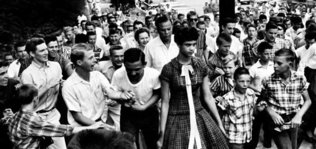Don Sturkey doesn’t shoot many photos anymore. He owns a cheap digital camera, but hasn’t mastered all its functions. Sturkey’s career ended before digital photography arrived.
But what a career it was.
For nearly 40 years at The Charlotte Observer, Sturkey took pictures of presidents and movie stars, protesters, Klan members and average citizens. He recorded for posterity shanties leveled by urban renewal and grand construction projects that changed the face of Charlotte.

LBJ in North Carolina: In May 1964, President Lyndon Johnson visited with tenant farmer William Marlow and his family outside Rocky Mount to publicize his War on Poverty. N.C. Gov. Terry Sanford sits to his right.
His work has placed him in the N.C. Journalism Hall of Fame and earned his negatives a permanent home in UNC Chapel Hill’s library.
Now, Sturkey, 81, has assembled 218 photographs in a new collection, “This Old Wheel Will Roll Around Again: A Pictorial History of the South, 1950-1990.” The book recalls events that shaped America in the second half of the 20th century: the Civil Rights and Women’s movements, the Cold War, the War on Poverty, the Vietnam War.
It also illustrates the transformation of North Carolina and the South, a transition UNC Charlotte historian David Goldfield describes as moving from “a region apart from the United States to becoming an integral part of the nation, not only in terms of race – that’s paramount – but also in terms of economic development.”
The role of photography was crucial during this period, Goldfield says, not only in documenting history but in shaping public opinion.
“The old saying, ‘A picture’s worth a thousand words,’ it’s not true. Sometimes, a picture’s worth a million words,” he says. “You can actually see the emotions and see the tragedy and see the violence.”
Sturkey, who spent much of his childhood in Shelby, began his photographic career in the Navy. He worked at the Shelby Daily Star and High Point Enterprise.
When he joined the Observer in 1955, the city was segregated. Restaurants didn’t integrate until 1963. School desegregation came in the 1970s. By 1989, when Sturkey retired as chief photographer, Charlotte had shed its textile and manufacturing roots. It was becoming a banking powerhouse and had doubled in population to nearly 400,000.
Sturkey has an earlier photographic collection, “A Slice of Time: A Carolinas Album,” published in 1990. That book includes many of his favorite shots.
This new collection offers a different focus, documenting a changing political, economic and cultural canvas, with bygone images that include a Mecklenburg County cotton farmer, residents of Charlotte’s now-demolished African-American Blue Heaven neighborhood, a pensive young mill worker contemplating his future amid 1980s textile mill closures.
Never-before seen photos
Many shots will be new even to longtime Observer readers. Fewer than 100 of the 218 have run in the newspaper.
Sturkey also includes his best-known images. Perhaps his most famous: white students heckling Dorothy Counts as she integrates Harding High School in 1957. A copy of that photo is also on display in the Levine Museum of the New South.

Dorothy Counts: Sturkey’s most famous photo shows white students jeering as Dorothy Counts integrates Harding High School in 1957.
Getting this book to publication has taken Sturkey years. Several publishers, including university presses, examined it, he says, but turned it down. Printing the books, they knew, would have cost so much that the project was almost certain to lose money, given the high-quality reproduction that Sturkey demanded.
But his photos were his legacy. Finally, Sturkey published them himself. “I just decided, heck, I’m going to get the very best and do it.”
He designed and edited the book, but credits daughter Amy Sturkey, a pediatric physical therapist in Charlotte, for carrying out his design directives on the computer. “I’m just not capable,” he says. “That’s all there is to it.”
Photographing the truth
Sturkey took the book’s title from a Johnny Cash song. Johnny and June Carter Cash grace the cover, in a photo Sturkey shot when they performed at Garner-Webb University (then College) in 1971.
He has donated copies to 17 universities. He’s selling the coffee table-sized volume for $160. “Actually, I’m going to have to lose a bunch of money with the darn thing,” he says, “but I’m so happy about it, I’m happy as a lark.”
In the book’s opening essay, former Observer reporter Frye Gaillard writes that Sturkey’s photos help bring into focus the blur of societal change.
“Sturkey has given us bits and pieces of time,” Gaillard writes, “frozen to help us feel once again, or perhaps in a way that we never have before, the reality and the truth of the American South.”
–Pam Kelley, Charlotte Observer



